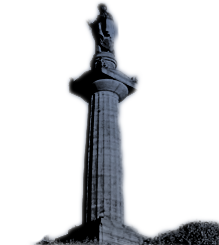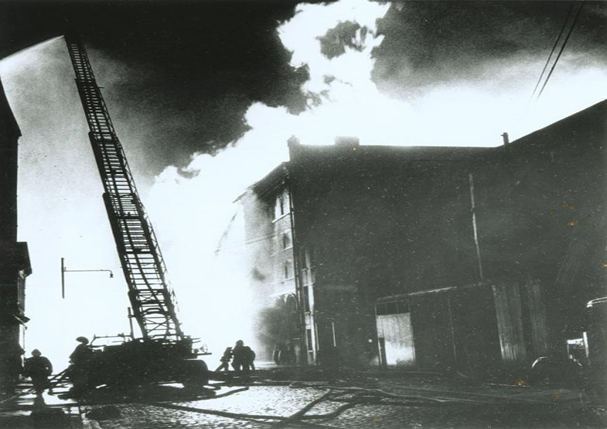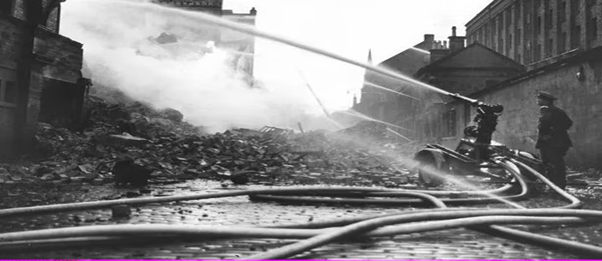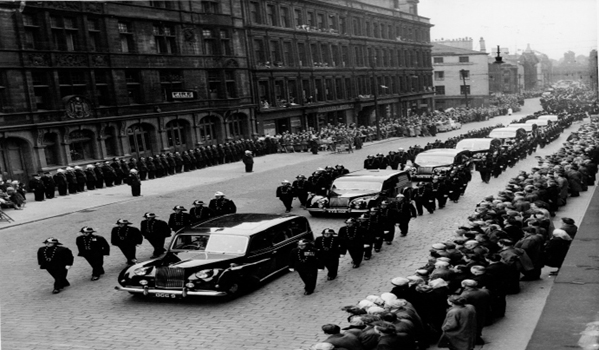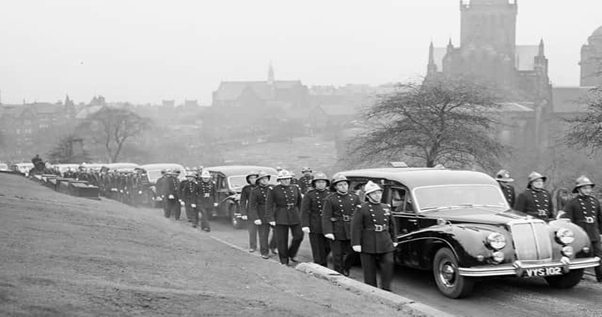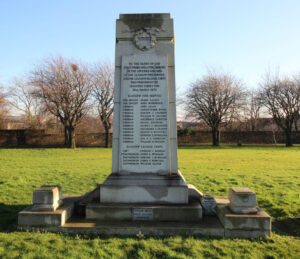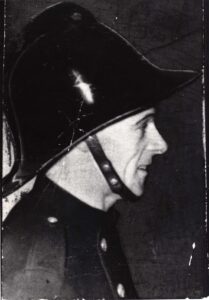Cheapside Street Disaster
28th March 2025 – The 65th Anniversary of the Cheapside Street Disaster
By Annette Mullen – Chair of the Friends of Glasgow Necropolis
On this the 65th anniversary of the Cheapside Street Disaster as it would later become known, The Friends of Glasgow Necropolis would like to pay tribute to the husbands, fathers, brothers and sons, who never came home that night, those men who lived, laughed and cherished those they cared about.
All but one was married most with children, their ages ranged from 25 to 55 years and with one year to 30 years of service.
They gave the ultimate price for the love of a city and its citizens that they took such great pride in keeping safe and secure. It was Britian’s worse peacetime fire services disaster.
On the evening of the Monday 28th March 1960, at 19.15, a member of the public (George Pinkston of the Eldorado Ice Cream Company) saw smoke coming from the 2nd floor of a bonded warehouse belonging to Arbuckle, Smith & Co Ltd., at 83 Cheapside St in Glasgow. He raised the alarm, not knowing how significant that night would be, and that it would be forever etched into the minds of the citizens of Glasgow.
The brick and cast iron warehouses were originally built in 1892 and consisted of several floors connected at different levels making them difficult buildings to navigate in situations such as this.
As the fire raged 450 firemen fought this inferno, every engine in the city was called in, 30 pumps, special equipment including the St Mungo fire boat which pumped water straight from the River Clyde was all deployed.
Sub Officer James Calder who lost his life that night, was one of the first to take command of the situation, at approx. 7.50pm an explosion occurred within the building, which was fuelled by more than a million gallons of whisky in 21,000 wooden casks and 30,000 gallons of rum which were all housed in the warehouse. Casks ruptured under the intense heat, resulting in a massive boiling liquid expanding vapour explosion.
Bright blue flames could be seen leaping 40 feet into the night sky, visible across the entire city.
The walls of the building blew out, with tons of masonry, bricks, dust and debris collapsing into the streets below, three fireman at the Cheapside St front of the building were killed instantly, these were the first of the bodies to be recovered later that evening but only after the inferno could be brought under control.
The fire crews were so focused on their task that it was not immediately realised that the wall at the back of the warehouse has also blown out into Warroch St, it was here than another eleven firemen and five members of the salvage corps had also been killed.
By 6.15am the following morning the bulk of the fire was extinguished but work went on for a week for dampen down the remains.
It would take up until the morning of Thursday the 31st March for the bodies of those killed in Warroch St to be recovered.
The City of Glasgow was shocked to its very core, as it became clear that fourteen firemen and five members of the salvage corps had been killed in this fire.
A public appeal was launched by Sir Myer Galpern, as he became who was Glasgow’s first Jewish Lord Provost (1958 – 1960) and for weeks after the tragedy, collection boxes could be found in almost every Glasgow pub, and shop which raised over £187,000 for the families left for those who never came home that night.
No cause was ever found for the fire, but it was thought an electrical fault or a dropped light were most likely the reason.
On Tuesday 5th April, the City of Glasgow fell silent as the funeral cortege which stretch more than 400 yards, passed from both St Andrew’s Cathedral and the Glasgow Cathedral. Flags were draped at half-mast and the citizens of Glasgow (more than 16,000) lined the streets in silent tribute to those brave men who had been lost.
The 19 men were laid to rest at the Glasgow Necropolis, the vault donated by the Merchants House of Glasgow.
A memorial plaque was unveiled on Sunday 7th August 1960 in the Appliance Room of the Central Fire Station by Baillie Philip Stinton J.P. & dedicated by the Rev Matthew Liddell B.D.
The following year in 1961 a monument funded by Glasgow Corporation was unveiled by Lord Provost Jean Roberts as a tribute to the firemen and members of the salvage corps who had sacrificed their lives in the service of the City of Glasgow. Dame Jean Roberts as she became was Glasgow’s first female Lord Provost (1960 – 1962), born in Springburn, who trained as a primary school teacher.
The following gives some small insight into the lives of the men who gave their lives that night, and we will always remember…..
Fireman John Allan, the youngest of the Firemen killed, was only 25 years old. He was based at the Central Fire Station in Ingram St. John was married with no children, he was a bandmaster at the Springburn Salvation Army and he lived at Muir St in Springburn. His was one of the first bodies recovered from the site.
Fireman Christopher Boyle was 27 years old, and was based at the South Fire Station in Centre St. Christopher was married and had one child and lived with his family at Waterside St in Oatlands, he had been in the fire service for four years.
Sub Officer James Calder was 46 years old, and was based at the West Fire Station in Cranston St. James was married and had two children and lived with his family at Starpoint St in Cranhill, he had a long career in the fire service giving 21 years.
Fireman Gordon Jarvie Chapman was 32 years old, and was based at the Central Fire Station in Ingram St. Gordon was the only one of the 19 lost who was not married, he lived at Colston Rd in Bishopbriggs, he had been in the fire service for two years. His was one of the first bodies recovered from the site.
Fireman William Wallace Crocket was 32 years old, and was based at the Central Fire Station in Ingram St. William was married and had three children and he lived with his family at Eddlewood Rd in Easterhouse, he had been in the fire service for nine years.
Fireman Archibald Darroch was 35 years old, and was based at the Central Fire Station in Ingram St. Archibald was married and had one child, he lived with his family at Liddesdale Rd in Milton, he had been in the fire service for ten years.
Fireman Daniel Davidson was 33 years old, and was based at the Central Fire Station in Ingram St. in Glasgow. Daniel was married and had two children, he lived with his family at Arnprior St in Castlemilk, he had been in the fire service for ten years.
Fireman Alfred Charles Dickinson was 31 years old, and was based at the Central Fire Station in Ingram St. Alfred was married and had no children, he lived at Henderson St in Maryhill, he had only been in the fire service for one year.
Fireman Alexander Grassie was 37 years old, and was based at the South Fire Station in Centre St. Alexander was married and had one child, he lived at the Central Fire Station in Ingram St with his family, he had been in the fire service for eight years.
Fireman George Dick McIntyre was 50 years old, and was based at the Central Fire Station in Ingram St. George was married and had three children, he lived with his family at the Northwest Fire Station in Kelbourne St, he had been in the fire service for 21 years. His was one of the first bodies recovered from the site.
Leading Salvageman James A McLellan was 48 years old, and was based at the Glasgow Salvage Corp Headquarters in Albion St. James was married and had three children, he also lived at the Savage Corp Headquarters with his family, he had been in the salvage corps for 19 years.
Fireman Edward Raymond McMillan was 26 years old, and was based at the South Fire Station in Centre St. Edward was married with no children and lived at the Central Fire Station in Ingram St, he had been in the fire service for 4 years.
The following information was kindly provided by the great niece of Edward (Marion Green).
Edward was the youngest brother of Marion’s maternal grandmother who always made sure his memory was carried on, she was fiercely proud of her brother and his sacrifice for the City of Glasgow, and sadly never really got over the death of her young brother.
The family were from Govan and Edward was raised there. Before joining the fire service Edward was in the army. He would have preferred to have joined the police but didn’t meet the height requirements, so the fire service it was, and his trade was plumbing.
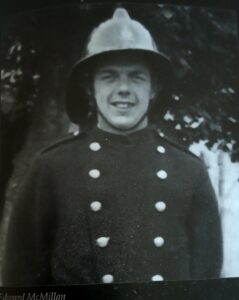
Fireman Edward Raymond McMillan – photo by kind permission of Marion Green
Salvageman Gordon C McMillan was 28 years old, and was based at the Glasgow Salvage Corp Headquarters in Albion St, Gordon was married and had four children, he lived with his family at Wardie Road in Easterhouse, and he had been in the salvage corps for four years.
Fireman Ian Archibald Cormack McMillan was 31 years old, and was based at the South Fire Station in Centre St. Ian was married and had one child, he lived with his family at Vicarsfield St in Govan, he had been in the fire service for seven years.
Please see the separate profile for Fireman Ian Archibald Cormack McMillan complied by Laura Middleton and Morag T Fyfe.
Sub Officer John McPherson was 47 years old, and was based at the South Fire Station in Centre St. John was married and had two children, he lived with his family at Garvock Dr in Arden, he had been in the fire service for 21 years.
Salvageman James F Mungall was 32 years old, and was based at the Glasgow Salvage Corp Headquarters in Albion St, James was married and had two children, he also lived at the Savage Corp Headquarters with his family, he had been in the salvage corps for nine years.
Superintendent Edward C Murray was 50 years old, and was based at the Glasgow Salvage Corp Headquarters in Albion St in, Edward was married and had three children, he also lived at the Savage Corp Headquarters with his family, he had been in the salvage corps for 30 years.
Salvageman William Oliver was 40 years old, and was based at the Glasgow Salvage Corp Headquarters in Albion St, William was married and had three children, he also lived at the Savage Corp Headquarters with his family, he had been in the salvage corps for 14 years.
Fireman William Robb Watson was 28 years old, and was based at the South Fire Station in Centre St. William was married and with no children, he lived at Partick Fire Station, he had been in the fire service for 4 years.
Links to videos:
This is the 50th Anniversary commemoration of the disaster.
https://www.youtube.com/watch?v=V2-Oe1Zyybc&ab_channel=HeraldGlasgow
This is a short Pathé video – Heroes Laid to Rest
https://www.youtube.com/watch?v=HAEm3Kf4jXY&ab_channel=BritishPath%C3%A9
A short video who shows footage of both the fire and the funeral procession
https://www.youtube.com/watch?v=bU5Uv9zvNIE&ab_channel=TrueBravery









